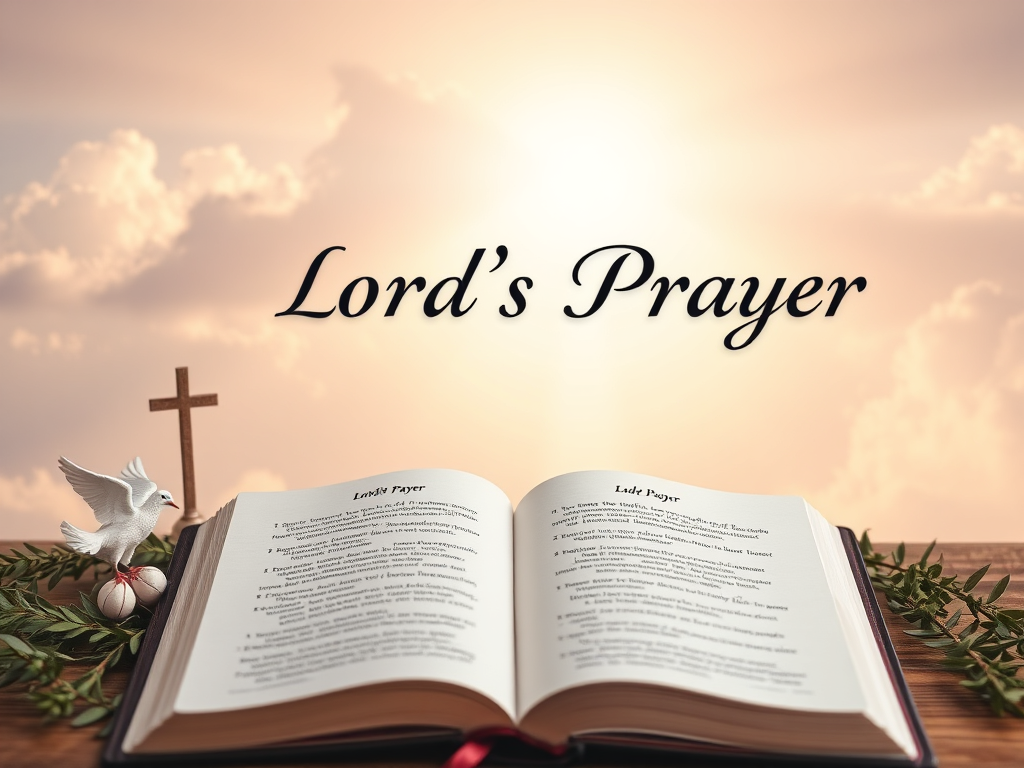The Lord’s Prayer stands as the cornerstone of Christian worship and devotion, representing the most fundamental prayer that Jesus taught his disciples. This sacred text has guided believers for over two millennia, offering a perfect template for how to approach God in prayer. Whether you know it in its traditional form or contemporary language, the Lord’s Prayer remains one of the most powerful expressions of faith in Christianity.
In this comprehensive guide, we’ll explore every aspect of this sacred prayer, from its biblical origins to its modern applications, helping you understand why millions of Christians worldwide continue to recite these holy words daily.
Our Father Prayer: The Foundation of Christian Prayer
The Our Father Prayer, as the Lord’s Prayer is often called, represents the direct teaching of Jesus Christ to his followers. When the disciples approached Jesus asking how to pray, he responded with this perfect model that encompasses all essential elements of communication with God.
The Our Father Prayer begins with an intimate address to God as “Father,” establishing the approachability of God and the community of believers as God’s children. This opening phrase revolutionized the way humans could relate to the divine, transforming prayer from formal ritual to personal conversation.
Key aspects of the Our Father Prayer include:
- Intimacy with God: Addressing the Creator as “Father”
- Reverence: “Hallowed be thy name”
- Submission: “Thy will be done”
- Dependence: “Give us this day our daily bread“
- Relationships: “Forgive us our trespasses”
- Protection: “Lead us not into temptation“
Padre Nuestro Prayer: The Lord’s Prayer in Spanish
The Padre Nuestro Prayer holds special significance in Spanish-speaking Christian communities worldwide. The Lord’s Prayer in Spanish maintains the same profound meaning while resonating with the cultural and linguistic heritage of millions of believers.
Traditional Spanish Version:
Padre nuestro que estás en los cielos,
santificado sea tu nombre.
Venga tu reino.
Hágase tu voluntad,
como en el cielo, así también en la tierra.
El pan nuestro de cada día, dánoslo hoy.
Y perdónanos nuestras deudas,
como también nosotros perdonamos a nuestros deudores.
Y no nos metas en tentación,
mas líbranos del mal;
porque tuyo es el reino, y el poder, y la gloria,
por todos los siglos. Amén.
The Padre Nuestro Prayer demonstrates how the universal message of Jesus transcends language barriers, maintaining its spiritual power across different cultures and communities.
The Lord’s Prayer King James Version: Traditional Excellence
The Lord’s Prayer King James Version represents one of the most beloved and historically significant translations in English Christianity. This traditional rendering has shaped Christian worship for centuries and continues to be recited in many Anglican and Protestant churches worldwide.
The Lord’s Prayer KJV (Matthew 6:9-13):
Our Father which art in heaven,
Hallowed be thy name.
Thy kingdom come,
Thy will be done in earth,
as it is in heaven.
Give us this day our daily bread.
And forgive us our debts,
as we forgive our debtors.
And lead us not into temptation,
but deliver us from evil:
For thine is the kingdom,
and the power, and the glory,
for ever. Amen.
The traditional language of the KJV carries profound reverence and has influenced Christian literature, hymnody, and worship practices for generations.
Our Father Who Art in Heaven: Understanding the Opening
The phrase “Our Father who art in heaven” establishes the fundamental relationship between humanity and God. This opening acknowledges several crucial theological concepts:
The Fatherhood of God
The term “Father” reveals God’s loving, caring nature toward humanity. Unlike distant deities of other religions, the Christian God is portrayed as intimately involved in the lives of believers, providing guidance, protection, and provision.
Collective Identity
The word “Our” emphasizes the community aspect of faith. When we pray the Lord’s Prayer, we join with believers worldwide, acknowledging our shared identity as God’s children.
Divine Transcendence
“Who art in heaven” recognizes God’s sovereignty and transcendence while maintaining the personal relationship established by “Father.”
Christian Jesus Prayer: The Master’s Teaching
The Christian Jesus Prayer, as the Lord’s Prayer is sometimes called, represents Jesus Christ’s direct instruction on how to pray. This prayer encapsulates the core principles of Christian faith and practice.
Jesus introduced this prayer in the context of teaching about worship and spiritual discipline. The Gospel accounts in Matthew and Luke preserve this teaching, showing its fundamental importance in New Testament Christianity.
Elements of the Jesus Prayer
- Adoration: “Hallowed be thy name”
- Submission: “Thy will be done”
- Supplication: “Give us this day our daily bread“
- Confession: “Forgive us our trespasses”
- Protection: “Deliver us from evil“
What is the Bible Verse Matthew 6:9-13?
Matthew 6:9-13 contains the complete text of the Lord’s Prayer as recorded in the Gospel of Matthew. This passage appears within Jesus’ Sermon on the Mount, specifically in his teaching about prayer and spiritual practices.
Matthew 6:9-13 (NIV):
“This, then, is how you should pray: ‘Our Father in heaven, hallowed be your name, your kingdom come, your will be done, on earth as it is in heaven. Give us today our daily bread. And forgive us our debts, as we also have forgiven our debtors. And lead us not into temptation, but deliver us from the evil one.'”
Context of Matthew 6:9-13
This biblical reference comes after Jesus’ teaching about:
- Secret prayer (Matthew 6:5-8)
- Avoiding repetitive, empty phrases
- God’s knowledge of our needs before we ask
The placement of Matthew 6:9-13 emphasizes the simplicity of prayer and authentic communication with God.
What is the Powerful Daily Prayer?
The Lord’s Prayer serves as the most powerful daily prayer for Christians worldwide. Its power lies not in magical formulas but in its comprehensive approach to spiritual life and relationship with God.
Why the Lord’s Prayer is Powerful
Daily repetition of the Lord’s Prayer provides:
- Spiritual discipline: Regular communion with God
- Mental framework: Proper priorities in life
- Emotional healing: Forgiveness and release from grudges
- Community connection: Unity with believers globally
- Divine protection: Seeking God’s guidance and deliverance
Making it Your Daily Prayer
To maximize the power of this daily prayer:
- Pray with intention: Focus on each phrase’s meaning
- Personalize petitions: Apply requests to your specific needs
- Practice forgiveness: Genuinely release resentments
- Seek God’s will: Align your desires with divine purposes
- Trust in provision: Believe God will meet your daily needs
How to Properly Pray to God?
The Lord’s Prayer provides the perfect template for how to properly pray to God. Jesus’ model demonstrates essential elements of effective prayer.
Proper Prayer Principles
Based on the Lord’s Prayer:
| Element | Principle | Application |
|---|---|---|
| Address | Approach God as Father | Personal, intimate relationship |
| Reverence | Honor God’s holiness | Worship and adoration |
| Submission | Seek God’s will | Surrender personal agenda |
| Petition | Request daily needs | Trust God for provision |
| Confession | Acknowledge sins | Seek forgiveness |
| Intercession | Pray for protection | Request divine guidance |
| Praise | Recognize God’s glory | End with worship |
Steps for Proper Prayer
- Prepare your heart: Find quiet space and time
- Address God respectfully: Use reverent language
- Express gratitude: Thank God for blessings
- Confess sins: Acknowledge failures and seek forgiveness
- Make requests: Present needs and concerns
- Intercede for others: Pray for family, friends, community
- Surrender to God’s will: Accept divine wisdom
- Close with praise: Honor God’s greatness
What is the Lord’s Psalm 23 Prayer?
While Psalm 23 is not technically part of the Lord’s Prayer, it represents another foundational prayer text in Christianity. Many believers combine the Lord’s Prayer with Psalm 23 in their daily devotional practices.
Psalm 23 complements the Lord’s Prayer by emphasizing:
- God’s shepherding care
- Divine provision and protection
- Comfort in difficult times
- Eternal hope and security
Connecting Psalm 23 with the Lord’s Prayer
Both texts share common themes:
- Trust in God’s provision (“daily bread” / “green pastures”)
- Protection from harm (“deliver us from evil” / “valley of death”)
- Divine guidance (“thy will be done” / “paths of righteousness”)
The Lord’s Prayer for Today: Modern Relevance
The Lord’s Prayer for today remains as relevant as when Jesus first taught it. Modern believers find comfort, guidance, and spiritual strength in these ancient words.
Contemporary Applications
The Lord’s Prayer for today addresses:
- Economic anxiety: “Give us this day our daily bread“
- Social divisions: “Forgive us… as we forgive others”
- Moral confusion: “Thy will be done”
- Security concerns: “Deliver us from evil“
- Identity crisis: “Our Father in heaven”
Modern Translation Benefits
Contemporary language versions help modern believers understand the prayer’s meaning:
Contemporary Version:
Our Father in heaven,
may your name be kept holy.
May your **Kingdom of God** come soon.
May your will be done on earth,
as it is in heaven.
Give us today the food we need,
and forgive us our sins,
as we have forgiven those who sin against us.
And don't let us yield to **temptation**,
but rescue us from the **evil** one.
The Lord’s Prayer in English: Translation Varieties
The Lord’s Prayer in English exists in numerous translations, each offering unique insights into the original Greek text. These variations help believers understand different aspects of Jesus’ teaching.
Major English Translations
- King James Version (1611): Traditional language, formal tone
- New International Version (1978): Modern, accessible language
- English Standard Version (2001): Literal accuracy with readability
- New Living Translation (1996): Contemporary, conversational style
- The Message (1993): Paraphrased for modern understanding
Translation Comparison Table
| Version | Opening | Daily Bread | Forgiveness |
|---|---|---|---|
| KJV | “Our Father which art in heaven” | “Give us this day our daily bread“ | “Forgive us our debts” |
| NIV | “Our Father in heaven” | “Give us today our daily bread“ | “Forgive us our debts” |
| NLT | “Our Father in heaven” | “Give us today the food we need” | “Forgive us our sins” |
Glory Be Prayer: Complementing the Lord’s Prayer
The Glory Be Prayer often accompanies the Lord’s Prayer in Christian worship. This doxology provides a fitting conclusion to the petitions of the Lord’s Prayer.
Traditional Glory Be:
Glory be to the Father,
and to the Son,
and to the Holy Spirit.
As it was in the beginning,
is now, and ever shall be,
world without end. Amen.
The Glory Be Prayer connects with the Lord’s Prayer’s ending: “For thine is the kingdom, and the power and glory, for ever.”
Apostles Creed Prayer: Foundation of Faith
The Apostles Creed Prayer serves alongside the Lord’s Prayer as a fundamental statement of Christian faith. While the Lord’s Prayer teaches us how to pray, the Apostles Creed declares what we believe.
Core Beliefs in the Apostles Creed:
- Trinity: Father, Son, Holy Spirit
- Incarnation: Jesus became human
- Salvation: Death and resurrection of Christ
- Church: Community of believers
- Eternal life: Hope beyond death
Together, the Lord’s Prayer and Apostles Creed provide comprehensive guidance for Christian living and believing.
Where is the Lord’s Prayer in the Bible?
Where is the Lord’s Prayer in the Bible? This question leads us to two primary biblical references:
Primary Locations
- Matthew 6:9-13: Complete version in Sermon on the Mount
- Luke 11:1-4: Shorter version in response to disciples’ request
Matthew vs. Luke Versions
| Aspect | Matthew 6:9-13 | Luke 11:1-4 |
|---|---|---|
| Length | Longer, more detailed | Shorter, more concise |
| Context | Sermon on the Mount | Disciples request instruction |
| Doxology | Includes “For thine is the kingdom…” | Omits doxology |
| Debts/Sins | “Forgive us our debts” | “Forgive us our sins” |
Historical Development
The Lord’s Prayer appears in the earliest Christian documents:
- Gospel manuscripts from 2nd century
- Didache (early Christian manual)
- Liturgical texts from 3rd century
Deeper Spiritual Insights
The Kingdom of God Theme
The Lord’s Prayer centers on the Kingdom of God – God’s rule in human hearts and society. “Thy kingdom come” represents the prayer’s central petition.
Forgiveness of Sins Emphasis
The prayer uniquely connects divine forgiveness with human forgiveness: “as we forgive our debtors.” This reciprocal relationship emphasizes the importance of releasing resentment.
Daily Needs vs. Treasures in Heaven
The request for “daily bread” keeps believers focused on essential needs rather than accumulating treasures that distract from spiritual priorities.
Practical Applications for Modern Believers
Building Faith Through Regular Practice
Consistent recitation of the Lord’s Prayer strengthens faith by:
- Reinforcing core Christian values
- Providing spiritual discipline
- Creating connection with global Christianity
- Offering comfort during difficulties
Teaching Children the Prayer
Parents and educators can use the Lord’s Prayer to:
- Introduce children to prayer concepts
- Teach fundamental Christian beliefs
- Establish family worship traditions
- Build spiritual vocabulary
Using in Worship Services
Churches incorporate the Lord’s Prayer through:
- Congregational recitation
- Musical settings and hymns
- Liturgical responses
- Meditation and reflection
Conclusion: The Eternal Relevance of the Lord’s Prayer
The Lord’s Prayer continues to serve as Christianity’s most essential prayer because it addresses universal human needs: relationship with God, daily provision, forgiveness, and protection from evil. Whether recited in traditional or contemporary language, in English or Spanish as the Padre Nuestro, this sacred text connects believers across cultures and centuries.
Jesus’ simple yet profound teaching provides a complete framework for spiritual life. From the intimate address “Our Father” to the triumphant conclusion acknowledging God’s “power and glory,” every phrase carries deep meaning for modern believers.
As you incorporate the Lord’s Prayer into your daily spiritual practice, remember that you join millions of Christians worldwide who find strength, comfort, and guidance in these sacred words. The prayer that Jesus taught his disciples remains as powerful today as it was two thousand years ago, offering hope and direction for all who seek to draw closer to God.
Whether you prefer the majestic language of the King James Version or the clarity of contemporary translations, the Lord’s Prayer stands ready to transform your spiritual life and deepen your relationship with the God who loves you as a perfect Father.

Catherine Frank, founder of BiblicalHorizon.com, shares daily prayers and Bible verses to nurture spiritual growth. With a lifelong passion for scripture and prayer traditions, she creates accessible spiritual content that resonates with both seasoned believers and newcomers seeking divine connection.



